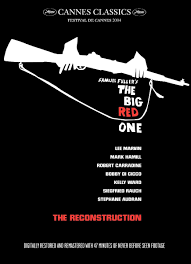Ironically, I call the Four Horsemen naïve in the following analysis and I feel that I was somewhat naïve in my treatment of this film (and the others for that matter). 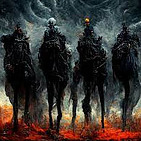 It is one of a very small number of films Mark Hamill did between Star Wars and The Return of the Jedi. So watch The Big Red One and Mark Hamill and be brought down to earth by the reality of a war on Earth.
It is one of a very small number of films Mark Hamill did between Star Wars and The Return of the Jedi. So watch The Big Red One and Mark Hamill and be brought down to earth by the reality of a war on Earth.
Despite this not being a book, this film is based on the director Samuel Fuller’s experiences during the Second World War. As such, it has a similar provenance to those films which are based on books.
Many of the criticisms made about the lack of scope of the film or the disjointed nature of it can probably be attributed to the relative lack of budget. It was $2 million less than Cross of Iron and about a sixth of A Bridge Too Far yet was set in at least six countries. I will say more of this later.
The Big Red One 1980
“The Big Red One is a powerful, humorous, and touching autobiographical film that’s the last of the great World War II movies… Fuller manages to create one of the most poignant films ever made. Fuller demonstrates his philosophy that, ‘the only glory is surviving.’
By focusing on the Four Horsemen and through a series of searing scenes filled with unforgettable images (a Nazi hiding behind a crucifix in the middle of the battlefield; terrified eyes of concentration camp prisoners) … Vehemently anti-militaristic, the film celebrates camaraderie and brotherhood and eloquently demonstrates the ultimate futility of war.”
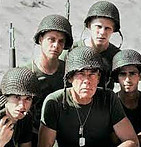
The film follows a small group of naïve soldiers led by The Sergeant (Lee Marvin) a First World War veteran. The four survivors of their first battles, the invasion of North Africa and the defeat at Kasserine Pass become veterans themselves and are nicknamed the Four Horsemen of the Apocalypse.
From North Africa, the film follows them and a stream of anonymous replacements to Sicily, Italy, the D-Day landings, the fighting through France and the Low Countries, and Germany itself. The story ends with their discovery of the horrors of the Holocaust in the Falkenhau concentration camp.
The Seventh Virgin Film Guide states that The Big Red One was both, “the last of the great World War II movies,” and that it was, vehemently anti-militaristic,” by demonstrating the “futility of war,” contradicts itself because the guide compares this film against movies produced in the earlier period considered in this study. It was this period, more than any other glorifies the pursuit of war rather than this film where war is not glorified. However, the guide does highlight several pertinent points of interest.
The key here is that The Big Red One is anti-war in nature. The characters, especially the narrator, Private Vinci (Bobby Di Cicco) and the Sergeant constantly stress their anti-war beliefs and the bleakness of human conflict. One such example is when the squad is crossing the French battlefield and comes across a cenotaph. A new replacement remarks.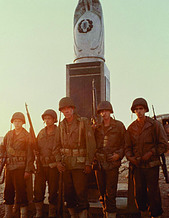
“Would you look at that, they put up the names of all our guys that got killed.”
“That’s a World War I memorial.” The Sergeant answers.
“But the names are the same.”
“They always are.” The Sergeant replies.”
At this point, the Sergeant is particularly affected by the futility of war because they are crossing the same French battlefield that he fought over in the last days of the First World War. It was here that he killed a surrendering German after the armistice.
His inner turmoil about this killing which he classes as murder is brought up in the final minutes when he is again confronted by a surrendering German, unaware that the war has already ended. He attacks the soldier and thinking he has killed him, leaves him. The remaining Horsemen discover him still alive and revive him. Vinci, the narrator, again pinpoints the central theme of the film:
“Saving that Kraut was the final joke of the whole goddamned war. I mean, we had more in common with him than with all our replacements who got killed, whose names we never even knew. We’ve all made it through, we’re alive. I’m going to dedicate my book to all those that shot but didn’t get shot because it’s about the survivors. Surviving is the only glory in war if you know what I mean.”
The proposed dedication is significant because many earlier dedications were exclusively aimed at Allied soldiers, whereas this is aimed at all who had survived. This is a theme also adopted with the dedication for Memphis Belle in 1990.
In this way, the film continues the theme of more sympathetic treatment of German soldiers, with a clear distinction made between the ordinary German soldier and the concentration camp guards. This attempts to show that individual soldiers on both sides had similar doubts, a fact elaborated on when the subject of murder arises. Griff (Mark Hamill) tells the Sergeant:
“I can’t murder anybody.”
“We don’t murder, we kill.” The Sergeant replies.
“It’s the same thing.”
“To hell it is Griff! You don’t murder animals, you kill them.”
In the subsequent scene in the German camp, the same discussion arises.
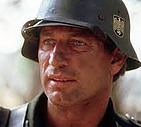
“In Libya, I saw him [Schroeder] (Siegfried Rauch) murder a German officer.” Private Gerd says.
“I did not murder him. I killed him when he ran from a fight with the British.” Schroeder replies.
“Murder, kill, it’s the same thing.”
“We don’t murder the enemy, we kill them.”
Even though the characters from both sides arrive at similar conclusions in an argument about the justness of war, a similar distinction is made between the fanatical Nazis and the ordinary Germans as was made in The Great Escape.
The fanatical Nazis are evil whereas anyone who disagrees with the Nazis is their enemy, a point made when Schroeder shoots Gerd immediately after the dialogue given above because he has ridiculed the Nazis and refused to fight. Therefore, this film does not go as far as Cross of Iron in its treatment of German characters, it is the Nazi character, Schroeder, that follows the Four Horsemen wherever they go.
By adopting an anti-war stance that does not glorify the war, Fuller has tentatively been able to include the Holocaust in the final segment of the film. Here, the film is at its most gritty as it deals with the contentiousness of the Holocaust through the visible anguish that all the characters suffer.
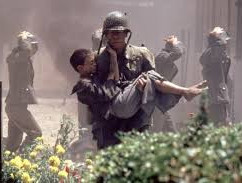
Elsewhere, the film fails to convey any great feeling of reality, especially during combat. This is mainly due to the almost slapstick appearance of bullets striking objects, as, during the North African invasion, bullets appear as small puffs of sand as they strike. More noticeably this occurs during the attack on a monastery when one of the mentally ill patients grabs a weapon and fires into the crowded dining room with bullets causing no more damage than destroying a few bits of crockery.
The constant movement of the squad between different countries creates a piecemeal story that further underlines the unrealistic nature of the film.
The Big Red One includes a great deal of interaction between principal characters, a theme not always common in earlier war films. The story was an autobiography of a private soldier with most dialogues occurring between a few squad members.
One seldom sees the vast numbers involved in a battle, which generates a lack of grandeur. Saving Private Ryan also focused on a small squad but conveyed a feeling of grandeur with the characters being part of a much larger event.

The local interaction between lower-ranking soldiers and their desire for personal survival are features that set this film within the characteristics of later Second World War films. Unfortunately, however, the comedy in some scenes combined with the lack of scale draws attention away from the serious anti-war message the film is attempting to portray. In this way, the film does not appear as emotionally bleak as either Cross of Iron or Schindler’s List.
At some stage, a more thorough analysis will be made based upon more up-to-date research and that will consider whether The Reconstruction version will have an effect. Memphis Belle is up next for the BigT touch followed by a Steven Spielberg double bill of Schindler’s List and Saving Private Ryan.
If you have found these posts about films interesting, then have a look at my blog about comedy in war films and TV series, and feel free to comment.
All the best
BigT
